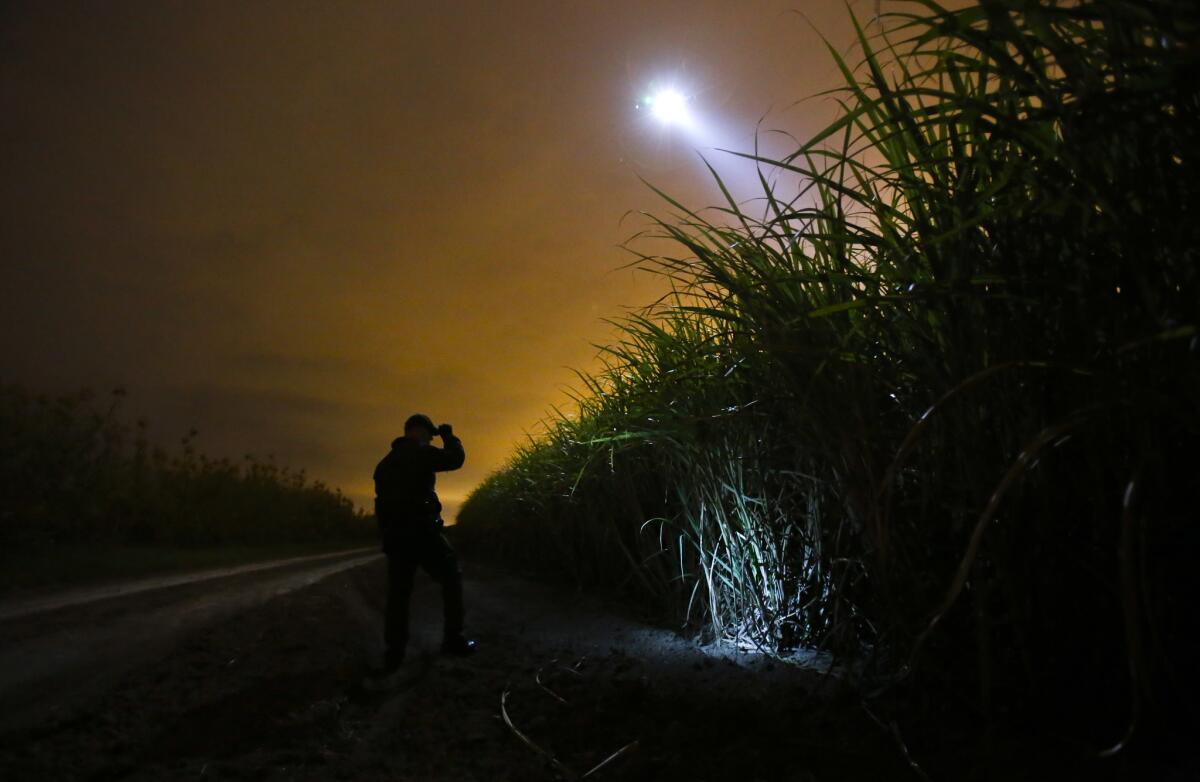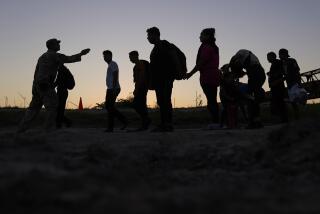Immigrant deaths along Mexico border decrease, officials say, but critics are left wondering

Border Patrol agents search along the border with Mexico near McAllen, Texas.
For the third straight year, migrant deaths along the southern border have decreased, even in some areas where the number of migrant children and families crossing increased over the summer, authorities said Tuesday.
U.S. Customs and Border Protection reported that there were 240 migrant deaths at the border for the fiscal year that ended in September, down from 308 deaths last year and 365 five years earlier.
The number of migrants caught nationwide (mostly at the southern border) also dropped in the fiscal year, from 486,651 the year before to 337,117 — a 31% change. Apprehensions had increased the last four years after trending downward for decades.
Homeland Security Secretary Jeh Johnson called it a “dramatic decrease ... reflecting a lower level of attempted illegal migration at our borders.”
In the new fiscal year, Johnson said, “we will be challenged again by a variety of factors driving illegal migration to the U.S., mostly from Central America, and we are redoubling our border security efforts now to meet that challenge.”
Though 42% fewer migrant children and families — 39,838 family units and 39,970 unaccompanied children — were caught compared with the previous fiscal year, a decline early in the year was reversed by summer.
The numbers jumped this fall, with more than 12,500 family units and 10,500 unaccompanied youth caught in the last two months — more than twice the number caught in the same period the previous fiscal year. Most are Central Americans fleeing violence and deteriorating economic conditions in Guatemala, Honduras and El Salvador, mainly through Texas.
Texas Gov. Greg Abbott, a Republican, announced this month that he was extending the deployment of National Guard troops along the border and taking additional steps to increase security. On Wednesday he plans to visit troops in the Rio Grande Valley, the epicenter of the latest influx of migrants.
Border Patrol officials credit the drop in migrant deaths to the agency’s ability to apprehend more stranded migrants. But immigrant advocates say the picture is probably far more complicated.
In the Rio Grande Valley, in the southern tip of Texas, agents reported 97 deaths in the fiscal year compared with 116 the previous year. Border Patrol officials said better surveillance technology and more robust inland checkpoints probably helped in that decline.
“It has reduced deaths,” acting Chief Patrol Agent Raul Ortiz said during a visit to a checkpoint last week. “And rescues are up. I’m putting more search and rescue teams out there; we’re putting helicopters out there, border-watch teams and ranchers.”
Smugglers often drop migrants in ranchland south of the checkpoint, promising to pick them up on the other side. In recent years, many people got lost or died on the massive ranches — including the fabled King Ranch, as large as the state of Rhode Island.
In the new fiscal year, there have been nine deaths in the Rio Grande Valley compared with 25 in the same period last year, he said.
“We do everything we can to triangulate where they are and get out there,” Ortiz said.
Agents in the Rio Grande Valley have rescued 136 migrants so far this fiscal year compared with 115 in the same period last year, Ortiz said.
But some immigrant advocates dispute those figures.
Eddie Canales, director of the South Texas Human Rights Center in Falfurrias, noted that the Border Patrol’s definition of “rescue” includes more than just migrants saved in the field; for instance, those found being smuggled in vehicles stopped at checkpoints are considered rescued.
His count of migrant deaths in Brooks County is also down: At least 45 this calendar year compared with 61 last year.
Canales suspects the recorded death toll would be higher if the Border Patrol spent more time and resources searching for migrants who might have gone missing in the vast Rio Grande Valley.
Migrant deaths in the Rio Grande Valley are still more than triple what they were five years ago. Some areas of the border saw a slight increase in deaths last fiscal year, including Yuma, Ariz., and El Paso, which have seen an increase in unaccompanied children and families crossing as smugglers shift west of the Rio Grande Valley, experts say.
In Brooks County, Canales installs water barrels on ranchland for stranded migrants, fields phone calls from relatives of the missing — up to 50 a month — and searches for remains.
“Overall things are not getting better,” Canales said. “I will not be satisfied until we have no more deaths.”
Twitter: @mollyhf
More to Read
Sign up for Essential California
The most important California stories and recommendations in your inbox every morning.
You may occasionally receive promotional content from the Los Angeles Times.










